Webinar text. Page 3
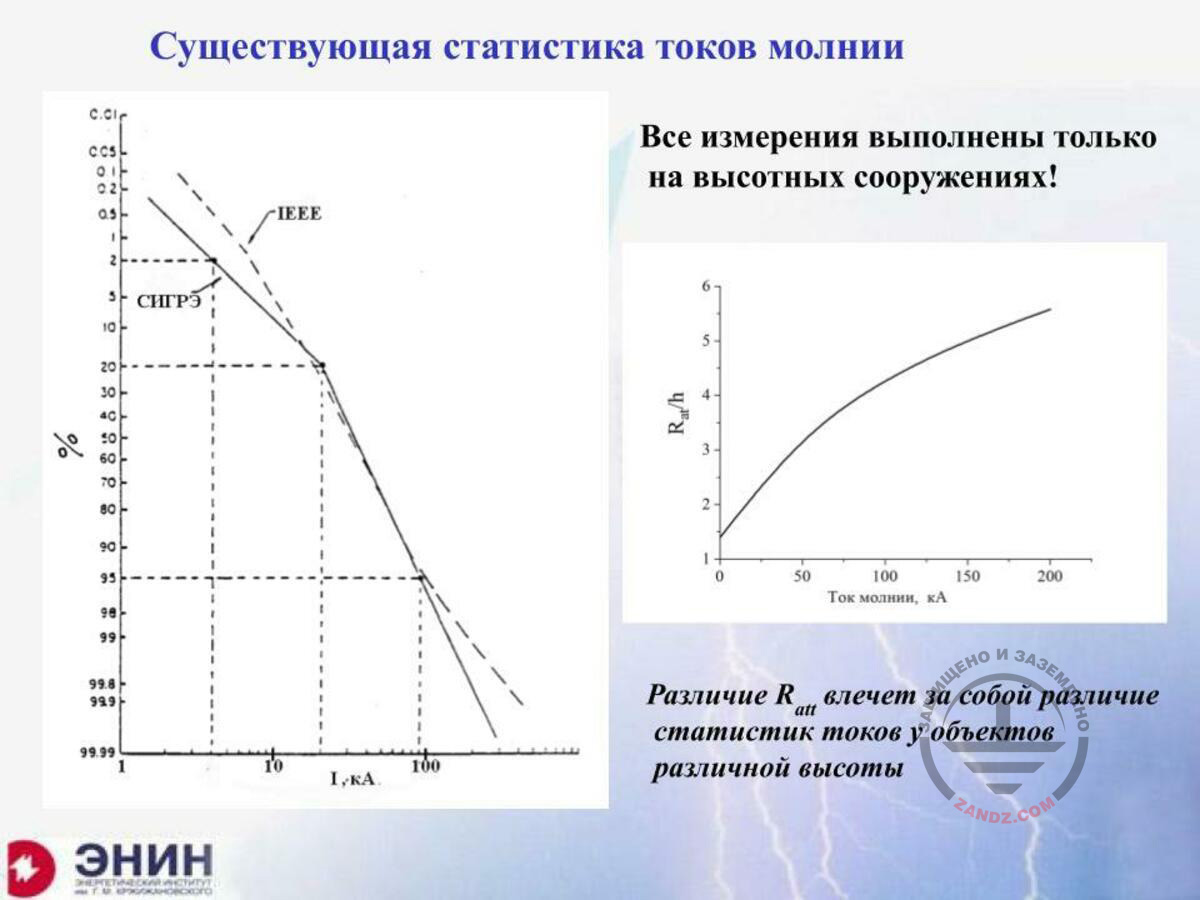
Available lightning current statistics
Существующая статистика токов молнии
Все измерения выполнены только на высотных сооружениях
СИГРЭ
кА
Ток молнии, кА
Различие Ratt влечет за собой различие статистик токов у объектов различной высоты
Available lightning current statistics
All measurements are made only in the high-rise structures
CIGRE
kA
Lightning current, kA
Difference in Ratt causes the difference in the current statistics for the facilities of different heights
I will not talk about the foreign protection zones since we have discussed them before. However, we have to talk about the available lightning current statistics. Everything I said was associated with the fact that some certain currents are dangerous while others are not, and we have to consider these certain currents. How did we obtain the current statistics? Where did we take the entire statistics you can see now? It was collected on the basis of records made in the high-rise facilities. For example, most people know the Berger's records made in Switzerland, primarily based on which the curve shown here was plotted. This curve that exists in almost all regulatory documents was plotted on the basis of the Berger's records made in the 70-meter high tower. But the specialists forget to note that the tower is located on San Salvatore that is 600 meters high. This mountain is almost non-conductive because the earthing device for this tower is lowered into Lake Lugano, and thus, the natural height of this tower is about 670 meters. The Russian records were made in the Ostankino Tower, which is 540 meters together with the flagstaff. And almost all current records were made for high-rise facilities. But in the lightning protection, we usually deal with the conventional facilities that are not high-rise at all. This one is 30 meters high, this one is 50 meters high, sometimes it can be 100 meters. What is their current statistics? Who knows it? We have reasons to believe that it is a completely different statistics because the lightning attraction radii depend on the charge that is carried by the lightning. And its current also depends on the charge. And the lightning current statistics may be absolutely different. We generally do the following thing. You know, I remember a joke about the drunk man who was looking for the keys under the street lamp because it was lighter there, although he lost them in the forest.
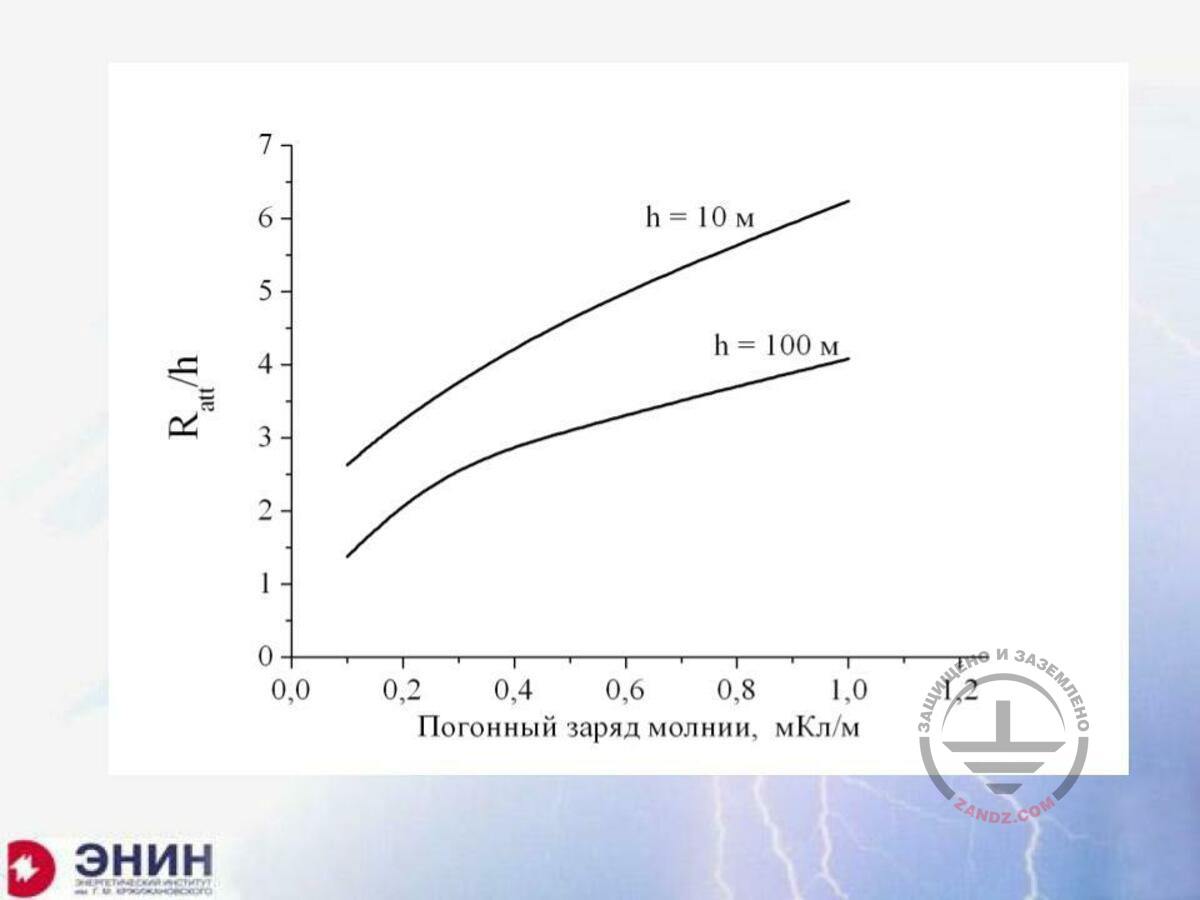
Facility observation range
h = 10 м
h = 100 м
Погонный заряд молнии, мКл/м
h = 10 m
h = 100 m
Linear lightning charge, mC/m
This is a very critical issue. It turns out that if I use an average height of, for example, 10–20 and up to 50–100 meters within a facility observation range, their behavior in relation to the lightning will not differ significantly. And if I then average all the collected data to an average height, for example, 50 meters, I will obtain a sufficiently reliable current statistics. It appears that if I provide at least one thousand facilities with good lightning current recorders, then during 5–10 years of observations I will obtain the statistics that will provide me with the actual lightning currents that strike the actual facility. And this can be performed.
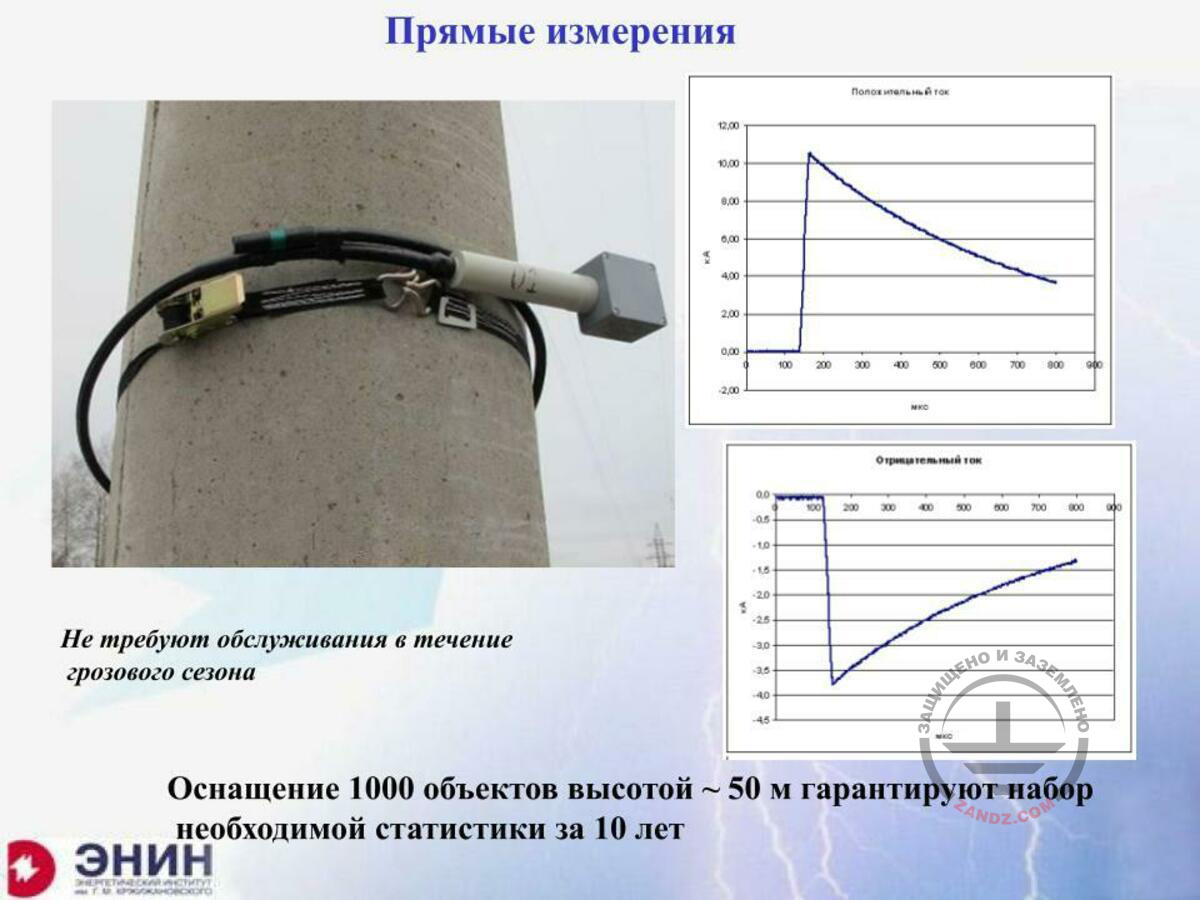
Direct measurements
Прямые измерения
Не требуют обслуживания в течение грозового сезона
Положительный ток
Отрицательный ток
Оснащение 1000 объектов высотой ~ 50 м гарантируют набор необходимой статистики за 10 лет
Direct measurements
Do not require maintenance for a storm season
Positive current
Negative current
Equipping 1,000 facilities with the height of about 50 m ensures the collection of the required statistics for 10 years
They are possible because today we have the devices developed by the Russian specialists. And you can install them on the facilities I am talking about. Install them for the entire storm season and stop worrying about them. And such devices will provide the lightning current records as shown on these oscillograms with high resolution and will not require the power source or any maintenance during a storm season. And these devices are about 100 USD each. If we organize such work, then we will certainly obtain the source data using which we will be able to design a reliable lightning protection based on the dangerous current levels existing for this facility. And stop screwing around.
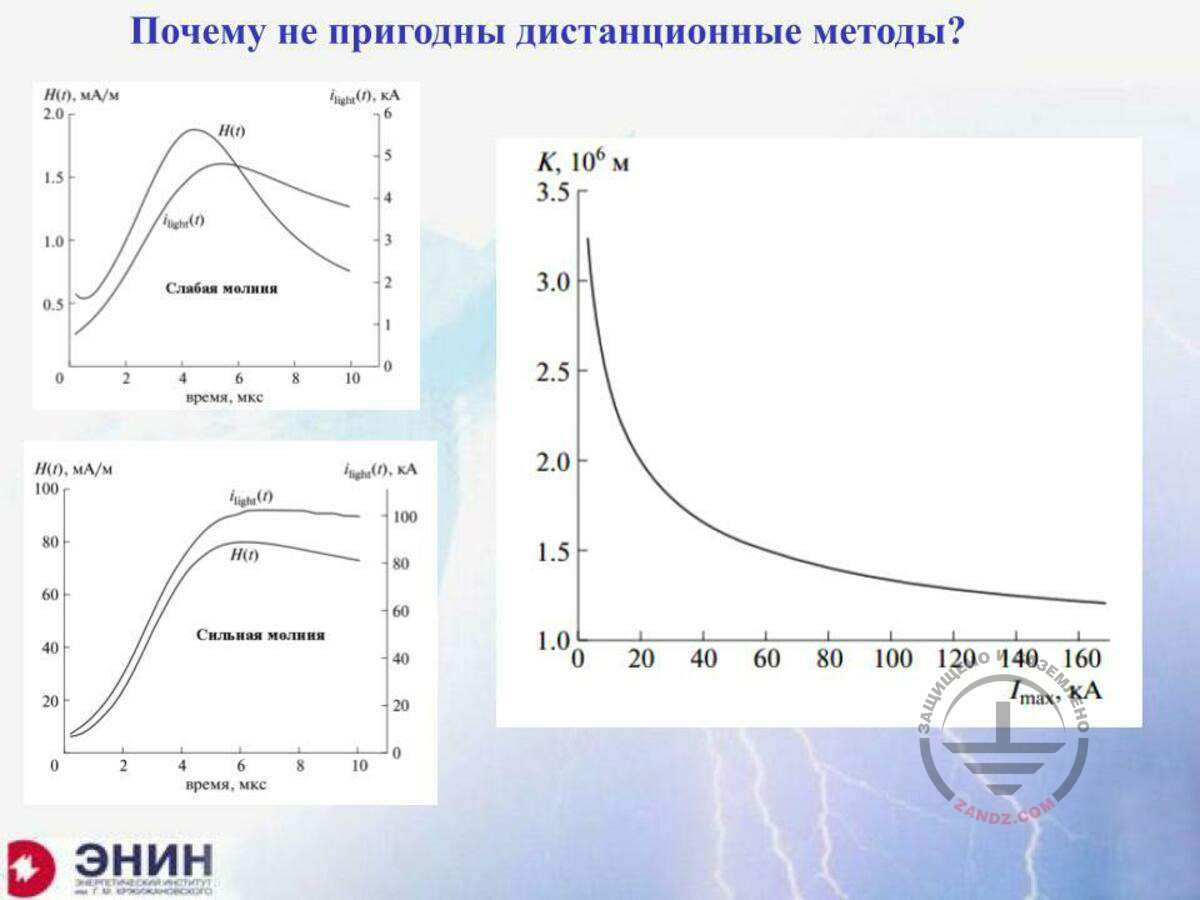
Why are the remote methods not suitable?
Почему не пригодны дистанционные методы?
мА/м
кА
Слабая молния
время, мкс
Сильная молния
Why are the remote methods not suitable?
mA/m
kA
Weak lightning
Time, mcs
Strong lightning
I may be asked the following question: "Good, you are going to install a thousand devices, but why cannot you use the remote methods?" Today, in the world, several companies, most of them having an American equity, including "Vaisala", "TOA" that sell the remote devices that can record the lightning discharge from the distance of 250 to 300 km, and they not only record the strike point with an error of 100 to 200 meters but also record the magnitude and time parameters of the lightning currents. And they will collect your statistics without any problem for a significant period of time. We have studied the capabilities provided by these devices. We contacted the developers, visited them and showed them the following thing. We showed that the emission you record in the remote zone with your sensors depends strongly on what lightning provides such emission. Because the current pulses that flow along the lightning channels have different amplitudes. As a result, the lightning channels have different temperatures. As a result of different temperatures, the lightning channel is characterized by different conductivity. When it moves along the channel, the current wave in the low-conductance channel fades away significantly, and in the high-conductance channel it fades away slightly. The electromagnetic pulses you record cannot be unambiguously deciphered in terms of current. And the ratio of such deciphering varies within about a half of the order of magnitude as a minimum. Therefore, the remote methods are not suitable for this. And when we showed this to the device developers, they said: "You have arrived at the wrong address. This development was made in another place". But show it to the developers and make them answer. We have not had an answer until now. This is the situation today. Therefore, when we talk about the future of lightning protection in Russia, I would say that the first point we need to discuss is the new regulatory document for lightning protection. And such new regulatory document must be cleared out of all the excessive information that was created for many years of operation. This is the first point. And the second is that we have to add strict requirements for the lightning impact into such regulatory framework that lacks them. And third, this regulatory framework should be based on the lightning current statistics we may consider reliable. And to obtain the current statistics we may consider reliable, we have to perform the direct measurements of the lightning currents once in a lifetime for the facilities to be protected. Unfortunately, this is an unlikeable picture of our future. It does not mean that we have to do nothing and wait until it all falls down on us.
Questions and answers
– Thank you, Eduard Meerovich! Dear colleagues, write your questions in the "Questions" tab. We already have questions and I will read them one by one. The first question is from Alexey Gerasimov: "What protection zone does an active lightning arrester have? Does the active lightning arrester match its claimed characteristics?"
– Could you ask a simpler question, please? I tell you once more. Nobody has ever verified the protection zones of the active lightning arresters. The advertising booklets of the companies contain the following information: "If you install the active tip onto the thirty meters high lightning arrester, then the protection zone radius that was about thirty meters for this lightning arrester will turn into about 150 meters". And then they say: "See Conformance Certificate". And I read this Certificate. What can I see? It describes what paint these lightning arresters are covered with, how they are protected against corrosion, and how their mechanical structures withstand the lightning current. All such information is contained therein, but it lacks any test results that would demonstrate that this lightning arrester has any protection zone. And then I ignore the regulatory documents, the certification documents, and look for the scientific results. What does the science provide? And it provides that during the comparative operation of the active lightning arresters and conventional lightning arresters of the same heights it turned out that almost all lightnings are caught by the conventional lightning arresters, because they just do not strike the active lightning arresters. It means that the protection zone of active lightning arresters is significantly narrower than that of the conventional arresters. It was obtained in three ways. In America, it was obtained by the live comparison of two types of lightning arresters for 2 years. In Russia, it was obtained during the tests with the voltage source of 6 mln volts that provided long sparks, and the comparison of striking frequency into the active lightning arresters and into the conventional arresters with the same height. And finally, by computer modelling and physical modelling that showed that it has to be like this and the active voltage exposures with the duration of microseconds instead of the required milliseconds result in the active lightning arrester blockage and failure. I do not know what kind of other evidence that such systems do not work are needed. And I do not understand the situation today. Our regulatory documents should react to the active lightning arresters. They must not be allowed in the form they are used today. I will keep saying that all the time. Anatoly, please read the next question.
– Thank you. "To what protection level can hospitals, schools, and kindergartens be classified?", asks Lyudmila.
– This question is not for me. We have got a single document that classifies buildings into the lightning protection categories. This document, RD 34.21.122-87, contains Table 1 generated in 1986. In this document, such buildings are classified to the third lightning protection category, as far as I remember, but that is not in all cases. Therefore, this question is not for me. The lightning protection category is determined not by the lightning protection experts but by the state authorities.
– Thank you. We had several questions related to the webinar subjects and to the webinars in English. I will answer them briefly. We plan webinar subjects for the next year. We will save your comments and try to use them and consider in the future. Question from Alexander: "Where can I read about the correct calculation method for the lightning protection for the protection zone location?"
– First, as far as I know, ZANDZ company that provides this webinar, has got a software that is available for almost anyone. And they allow calculating any lightning arrester system for any system of protected structures having a height of not more than 150 meters. But there are no limitations for the number of lightning arresters, their types and designs. The system may perform calculations for any system of lightning arresters for the protected facilities. I will tell you why there are height limitations. Up to 150 meters, the major lightnings that strike the facilities, are downward lightnings that are created in the thunderclouds and go towards the earth. When the facility height reaches more than 150 meters, the upward lightnings become increasingly important, which start from the facility and go to the cloud. It is easier to provide protection from them. Such upward lightnings usually start from the highest points of structures. That is why it was done. Now, where can you read about this? You can do it here: our company that provides this webinar has published two books. I am their author. One of them is titled "Practical Lightning Protection Issues", and the second one is titled "Electromagnetic Compatibility with Lightning". I think you may find what you need in both books.
– You know, I would not use any data from RD 34. Why? I can explain. This document has been developed by the people who have deceased already. You cannot request anything from them, but they wrote that two zone types exist. Type A zone and type B zone. The reliabilities of these zones are not specified in the regulatory document. But it contains the methodological appendix that is essentially not a document although it is attached thereto. And it states that the lightning arresters of types A and B are very reliable. I think type A has a reliability of 0.995 and type B has a reliability of 0.95. We have verified these protection zones for a single lightning rod we are talking about. It turned out that the actual reliability of the lightning arrester of type B is 0.83, i.e. it is not acceptable, and the reliability of type A lightning arresters is, I believe, 0.94. But it has nothing to do with the real situation. Therefore, I advice to use the protection zones for the single lightning rods from SO 153-34.21.122.2003, wherein three zone types are provided: zone 0.9, zone 0.99, and zone 0.999. And it states that these zones have been calculated for the lightning arresters having a height of up to 150 meters for the reason I have explained. These zones have been verified many times and they match the real situation. That is what I wanted to say.
– Thank you. Clarification from Dmitry: "Tell us please about a lightning arrester with a shielding effect?"
– What are lightning arresters with a shielding effect? We had a special webinar for this, but I will tell you the point. In the large territory, for example, if you protect an electrical substation or a tank farm, you do not install lightning rods but hang wires. Our Russian practice is prejudiced with regards to the wires, for some reason they do not appear very efficient for them or I do not understand why. But if you hang such wires, what will you obtain? First, you will obtain the following thing: you may take the supports for these wires beyond the protected territory, and then the currents from the earthing devices of these supports will not get into the earthing circuit of the facility to be protected. This is the first significant advantage without any shielding effect. Therefore, the wire lightning arresters are extremely undesirable in locations with high earthing resistance. And now what the wires do? The wires, if you correctly select their diameters, begin shielding in the electrical field of a thundercloud. And if you make them with the correct step recommended by the respective instructions, then you will have a bulk charge cloud that will shield the electrical field of a thundercloud and reduce it near the earth surface where the protected facility is located over the entire territory covered with these wires. As a result of this, the reliability of the facility protection will increase to at least 0.999, and the number of strikes in the entire territory, including the wires, is reduced about 2 or 3 times. As a result, the number of dangerous electromagnetic effects is reduced 2- or 3-fold. It means that you immediately solve two problems: both obtain the reliability of protection from the direct lightning strikes and reduce the number of electromagnetic effects, and solve the electromagnetic compatibility issue. That is what I am talking about.
– Thank you. One more clarification: "Eduard Meerovich, how can we correctly perform calculations in the earthing device considering the step voltage?"
– Calculations? I repeat that electrical technicians cannot tell anyone of us what voltage is dangerous. Physiologists must provide such information. What does the regulatory framework in other countries state? For example, in Germany? In Germany, we have the following thing. The pulse effect of the lightning of over 6 kV may lead to the heart fibrillation, and that is all. And it is not specified what value is acceptable. Until we have no such particular value, it is very difficult to calculate the earthing device. But modern software allows calculating the step and touch voltages with any accuracy for any system of earthing devices. We can calculate but we cannot say if it is lethal or not, it is beyond our scope. Can you see that? What can we do? I cannot treat flu or even a running nose.
– Thank you for the comment. Question from Alexander: "In the picture with the protection for the tank farm, the protection zone delineates the perimeters only. Why is the diagonal protection zone absent?"
– It will be much worse on the diagonal and it will not give anything. That is why it is not shown.
– Thank you. We have some more comments. I want to read them. First, they write that the situation with lightning protection has changed. They thank you for developing this area and wish you as much energy and health as possible so that you could do that as long as possible.
– Thank you. I will hand these wishes over to my wife.
– Here is an interesting comment: "The idea of collecting and updating statistical data is very correct. Moreover, it would be great to perform such measurements in different areas with different elevations over the sea level".
– I understand well that it is very good to be healthy but it is much better to be healthy and rich. Therefore, we have to do that not only with different elevations over the sea level but also we have to consider the latitude ranges. To see what happens, for example, near the polar circle or near Sochi. Surely, this is needed, but it is the next level. Can you see that? And I would like to show you what minimum we can do, but we should not do the rubbish. I wanted you to get this idea. Now I understand that you really did and I will probably have supporters, which will make things easier for me. Thank you very much.
– Thank you! One more clarification. Probably this issue has been considered many times, but you may briefly answer it again: "Eduard Meerovich, if the regulatory documents are that bad, have any efforts been made and are the respective means applied to promote new regulatory framework? What can we do to move it forward?"
– You know... what did we want to obtain? In 2016, when another lightning protection conference was held, its task was to prepare the community to the fact that it is needed. Before it was done for the conference, the respective work has been performed by the Academy of Sciences. And we got a support in the Academy of Sciences regarding this. We hoped that the Academy of Sciences would create a work team that would involve the lightning protection experts, designers, and some regulatory authorities that perform such work. And certainly we need some money for that. But then, the following thing occurred. The major changes took place in the Academy of Sciences. The administration changed and all of this work had no effect. Will something be done next? I cannot manage the Academy of Sciences but I think, being a member of the organizational committee of the conference, that I will try to continue this work. We have to continue this work for sure. RD 34 contained incorrect zones as the document is outdated. It is very difficult to make designs according to it. We have SO 153, but it does not contain any values except for the ones that were taken from IEC in terms of the device dimensions. You cannot also use it to design in accordance with it, but we cannot take this anymore. We have got a way out that is followed by many rich authorities. They develop their own standards and say: "We do not care about your state regulatory documents. We will use our own standard." But we will not go far this way.
– One more question: "Eduard Meerovich, can you comment on the requirements of some experts about harmful exposure of the lightning current on the concrete reinforcement of the reinforced concrete foundations and metal structures of the building and on the need to use artificial current collectors and the earthing device for the lightning arrester earthing?"
– We have a Research Institute for Reinforced Concrete. Excellent experts working there studied this issue. I think that the lightning current does not provide any significant effect on the concrete reinforcement. They think that the lightning current may impact the condition of concrete because it is known that concrete suffers from the loads other than compression very badly. And therefore, when the Research Institute for Reinforced Concrete developed a proposal for using the foundations as earthing devices, they said that we had to take into account the danger of the reinforced concrete deformation upon the lightning current exposure. But they do not say how to evaluate such danger. Now imagine that people appeared who say: "Stop doing this. You cannot use the building's foundation as an earthing device. You just must do that!" What follows from this? How do you eliminate the use of the foundation as an earthing device? What should you do for it? You cannot solve this task technically. For example, if you install bare electrodes along the foundation perimeter and then calculate what amount of current will get into these electrodes and what amount of current will get into the concrete reinforcement of the foundation, you will see that you obtained nothing. Therefore, you cannot avoid this task. Foundations will always be used as the natural earthing devices. You can only eliminate this by investing lots of money, which is unsuitable for the wide-scale civil construction. Foundations will be used as the earthing devices in civil construction. There is no getting around that.
– Thank you! Dear colleagues, write in the chat if you have any more questions because I cannot see any new of them. If there are no more questions, then write that there are no questions. Note that we continue receiving acknowledgements to Eduard Meerovich for the interesting webinar, for valuable and useful information, as well as saying that the questions are relevant.
– I do not even know what to do. I read our safety instructions and see the dangerous voltage levels there. But they are provided for the exposure of up to 0.1 to a minimum of 0.01 second. And during the lightning exposure, it is not 0.01 second but rather 0.0001 second, can you see it? How can we standardize something in this case? Physiologists must do that. And there are no regulatory proposals or even just researches. This task is not related to lightning protection or even to high-voltage equipment. In general, it is a task of state policy. And particularly today, since earlier we referred to that we had to lay asphalt in the public places, and then this asphalt layer of 5 or even 10 cm will be an insulation that protects people. But today the tile is increasingly used. And tiles are laid with the gaps, and there is an ordinary soil in the gap, and no insulation is provided by such tiles. But we can experience the consequences if we do not provide any strict requirements. Therefore, I am talking about this today, since it is an important issue of the future lightning protection.
– Thank you. Dear colleagues, we are running out of time. Thank you very much for your participation. I can see two more questions. We will process them and answer.
– Perhaps I can answer them within a minute? Read them.
– OK. If you have two minutes, I will read them. The first question is: "Is the shielding angle method for lightning rods shorter than 150 meters correct?" I mean, is it correct for small lightning arresters?
– If you are talking about the shielding angles provided by standard IEC 62305, then it is not. I will explain why. Because the zones according to the shielding angles as per IEC start from the lightning arrester's top. The protection zone may not start from the lightning arrester's top because the lightning arrester must have an elevation above the protected facility. The protection zone must start below the lightning arrester's top. Otherwise, the probability for such zone will be 50%. In this regard, the IEC protection zones are incorrect.
– Thank you. One more question: "Please indicate if the current collectors made of reinforcement, which are laid in the concrete columns, are dangerous, when the columns are laid inside the building but not along the perimeter?"
– The experience shows that there is no danger here. Why? Because you have many of these columns and the current is distributed among significant number of reinforcement rods. Therefore, in each reinforcement rod, the interference (induced voltage drop) usually cannot break through the dry concrete layer because there are the internal columns that separate the reinforcement rods from people. The practice shows that there were no cases when the people suffered from this to any extent. If you mean the step voltage in the street, then there were many cases. But in this case, the practice shows that it does not happen here.
– Good, thank you! We will finish at this point. Eduard Meerovich, thank you very much from me and from the participants. We have received many comments on this.
– We will hope for that. Thank you! Bye!
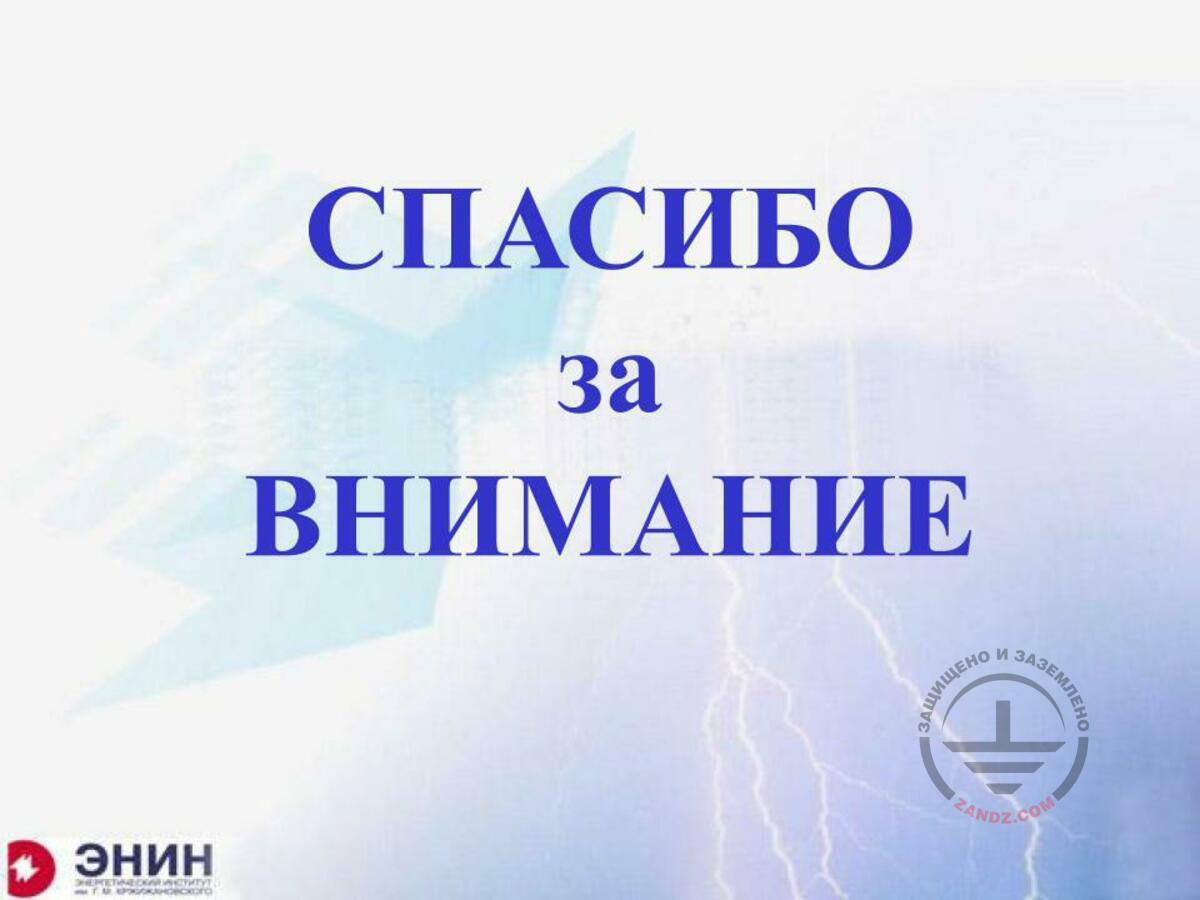
Thank you for attention
СПАСИБО за ВНИМАНИЕ
THANK YOU for ATTENTION
<< Previous page
slides from 8 to 14
Related Articles:
 Lightning Protection of Large Territories: Parks, Grounds, Plant Territories. Page 1
Lightning Protection of Large Territories: Parks, Grounds, Plant Territories. Page 1
 Lightning Protection of Large Territories: Parks, Grounds, Plant Territories. Page 2
Lightning Protection of Large Territories: Parks, Grounds, Plant Territories. Page 2
 Lightning Protection of Large Territories: Parks, Grounds, Plant Territories. Page 3
Lightning Protection of Large Territories: Parks, Grounds, Plant Territories. Page 3

